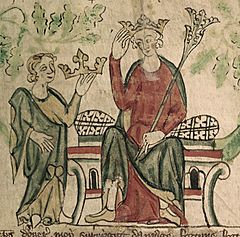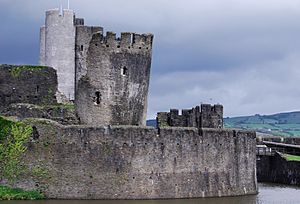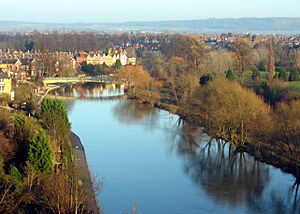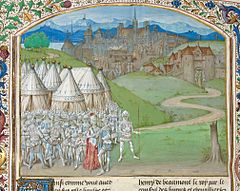Despenser War facts for kids
The Despenser War (1321–1322) was a fight in England between King Edward II of England and some powerful noblemen. These noblemen, called Marcher Lords, were led by Roger Mortimer and Humphrey de Bohun. They were angry because of the huge influence of Hugh Despenser the Younger, who was the King's favourite.
After the rebels fought well in the summer of 1321, King Edward used a short peace to gather more support. He then launched a successful campaign in southern Wales during the winter. This led to his big victory at the Battle of Boroughbridge in northern England in March 1322. After winning, King Edward ruled much more strictly until he lost his power in 1326.
Contents
Why the War Started

The rebels' early success showed how strong the Marcher Lords were. These lords lived in areas along the border of England and Wales. After King Edward I conquered Wales, these lords still had special rights. They used their power to get involved in English politics.
Another reason for the war was the death of the last Earl of Gloucester. His huge lands in Ireland and Wales needed to be shared out. The important area of Glamorgan went to the younger Despenser. He was married to the earl's oldest sister, Eleanor.
A group of powerful nobles called the Lords Ordainers really disliked the younger Despenser and his father, the elder Despenser. This was because both Despensers had too much control over the King. The Ordainers had been formed in 1311 to make changes to the King's government. They wanted to limit his power and control the money. They had even forced the King's previous favourite, Piers Gaveston, to leave the country. Gaveston was later killed when he came back.
Roger Mortimer, his uncle Roger Mortimer de Chirk, and Humphrey de Bohun were strong enemies of the Despensers. The younger Despenser got many valuable gifts, properties, and lands in the border areas through his marriage to Eleanor. When Glamorgan went entirely to Despenser, it made his brothers-in-law, Roger d'Amory and Hugh de Audley, very angry. They felt cheated out of their rightful share of the lands. The Marcher Lords became even more hostile when Despenser started calling himself "Lord of Glamorgan" and "Earl of Gloucester."
First Part of the War: May to August 1321
Quick facts for kids First phase |
|||||||
|---|---|---|---|---|---|---|---|
 Caerphilly Castle, one of the Despenser properties Roger Mortimer took over in May 1321. |
|||||||
|
|||||||
| Belligerents | |||||||
|
Supported by: |
|||||||
| Commanders and leaders | |||||||
In February 1321, Mortimer, Hereford, and Lancaster agreed to attack the Despenser lands in Wales. King Edward reacted in March by gathering his army in Wales. He wanted to show that attacking the Despensers was like attacking the King himself, which was treason. The King went to Gloucester and asked the Marcher Lords to join him. Mortimer and Hereford refused.
King Edward gathered more forces and marched to Bristol. He again asked the Marcher Lords to meet him there in May. They refused once more.
Mortimer and Hereford quickly began their attack on the Despenser lands. Mortimer captured Newport, Cardiff, and Caerphilly in a fast eight-day campaign. Mortimer and Hereford then robbed and destroyed property in Glamorgan and Gloucestershire. After this, they marched north to meet Lancaster at Pontefract. The barons then made an alliance at Sherburn-in-Elmet in June. They called themselves the "contrariants" and promised to get rid of the Despensers for good.
King Edward had returned to London. He held his own parliament to decide what to do. Mortimer also led his army east towards London, reaching St Albans in late July. The city of London would not let Mortimer's forces in. His army then surrounded the capital. Lancaster arrived in August to help him. There was a tense standoff. The younger Despenser threatened the rebels from a ship on the River Thames. The barons threatened to destroy royal properties outside London if he didn't stop.
The Earl of Pembroke, a nobleman who wanted peace, tried to solve the problem. King Edward still refused to talk or send the Despensers away. So, Pembroke arranged for Queen Isabella to publicly beg Edward to exile the Despensers. This gave the King an excuse to send the Despensers away and calm things down. But it was clear Edward planned to bring them back as soon as he could.
Second Part of the War: October 1321 to March 1322
| Second phase | |||||||
|---|---|---|---|---|---|---|---|
 The River Severn where King Edward II defeated the Marcher Lords. |
|||||||
|
|||||||
| Belligerents | |||||||
|
Supported by: |
|||||||
| Commanders and leaders | |||||||
| Strength | |||||||
| 12,000 | over 1,000; less than 12,000 | ||||||
Even though there was a short break, by autumn 1321, the tension between King Edward and the nobles led by Thomas of Lancaster was very high. Both sides were gathering armies across the country. At this time, Queen Isabella went on a religious journey to Canterbury. She changed her usual route to stop at Leeds Castle. The castle's leader, Bartholomew de Badlesmere, had joined the King's opponents. Historians think Isabella did this on purpose for Edward, to create a reason for war.
Badlesmere was away, so his wife Margaret was in charge. When she refused the Queen entry, fighting broke out between Isabella's guards and the castle's soldiers. King Edward then gathered his supporters and surrounded the castle. He gave Isabella the Great Seal and control of the royal Chancery. Many moderate nobles and volunteers from London joined him because of the attack on the Queen. Some old records say he soon had 30,000 men, but this is probably too high. When the castle surrendered in late October, Badlesmere and his men were executed.
King Edward was now much stronger than in August. He brought the Despensers back from exile. It was clear his enemies could expect little mercy. Mortimer and Hereford went north to meet Lancaster. The three nobles confirmed they were still against Edward. However, Mortimer and Hereford had to go back to the Welsh Marches to deal with a peasant uprising. In December, Edward marched to Cirencester, getting ready to invade.
In the north, Lancaster tried to get help from the Scots. He hoped to bring more soldiers before Edward could take back Wales. In January 1322, Edward finally overcame resistance along the River Severn. He moved into the Marches. Even though they attacked and burned Bridgnorth, Roger Mortimer and his uncle, Roger Mortimer de Chirk, knew they had no chance. They surrendered at Shrewsbury on January 22, 1322.
Edward then turned north. The Despensers, who had secretly returned from exile in mid-January, helped him. After gathering his men at Coventry in February, he moved towards Burton on Trent. There, Lancaster and Hereford had fortified a bridge over the River Trent. Realizing they were outnumbered, the rebels pulled back. But on March 16, an army led by the Earl of Carlisle defeated them at the Battle of Boroughbridge. Hereford was killed in the fight. Lancaster and about forty other captured knights were beheaded soon after.
What Happened After

The victory meant King Edward and the Despensers were now fully in charge of England and the Welsh Marches. The Despenser War "completely changed the political situation in England." It caused the breakdown of the powerful group of nobles. This allowed Edward to get back the powers he had lost because of the Ordinances of 1311. With Thomas of Lancaster's death, the Scots, who had supported his rebellion to weaken the English in the First Scottish War of Independence, saw a chance to take his lands in The Great Raid of 1322.
Roger Mortimer was put in the Tower of London after he surrendered at Shrewsbury. Some of his supporters, like William Trussell, kept raiding Despenser lands. In August 1323, Mortimer escaped. He tried to help other rebels break out of Windsor and Wallingford Castles. He eventually fled to France. Later, Queen Isabella joined him there. She was supposedly on a peace mission, but she was actually looking for help from her brother, King Charles IV of France, to get rid of the Despensers.
Mortimer and Isabella got the help they needed in Flanders. In 1326, they launched a successful invasion of England. This invasion led to the executions of the two Despensers. King Edward II was removed from power and killed. Queen Isabella and Roger Mortimer then took control, ruling England from 1327 to 1330. Mortimer was hanged in November 1330. This happened by order of Isabella's son, King Edward III, after he took power from his mother and Mortimer.

